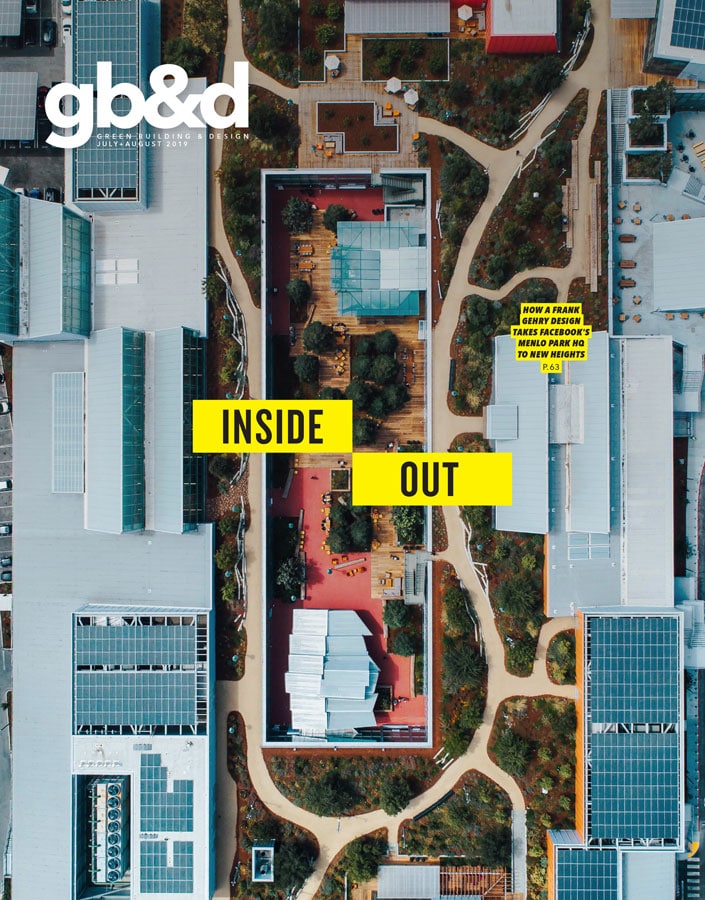
This residential project includes Nichiha’s horizontal vintage wood cedar. [Photo: Courtesy of Nichiha]
The high-performance siding market is changing, as architects are in search of affordable, beautiful solutions for projects everywhere. Increasingly, top architects are discovering that there really is an option for less costly, high design exteriors that isn’t wood, stucco, or vinyl; that option is fiber cement composite.
“Architects are struggling to find products that work with their budget,” says Tim Seims, market segment manager at Nichiha. It’s part of why Nichiha, a leading sustainable exterior and interior facades company, is meeting with municipalities and homeowners associations (HOAs) to educate them about the high design siding and cladding options that are available across budgets, and how exterior design impacts neighborhoods.
Part of that education includes dispelling old myths. It’s been said that fiber cement products all look the same, but that’s simply not the case. Seims says the myth can be traced back to the widespread use of thin commodity fiber cement products in multifamily buildings. Experts like Rick Mohler, an architect and associate professor at University of Washington, have attributed the uniform look of mixed-use, multi-family buildings to the overuse of neutral, fiber-cement siding, according to Curbed Seattle.
Thin fiber cement siding products have been popular because of their low cost and durability—but they don’t offer much in the way of design flexibility. Many cities, like Portland and Minneapolis, have limited the use of thin fiber cement products to 10% of the exterior of the building in an effort to reduce building uniformity. “The entire pipeline of projects utilizing thin commodity fiber cement products looks the same,” Seims says.
But thin fiber cement is not Nichiha’s value proposition. The Japanese company developed its Architectural Wall Panel offering, a shiplap-edge cement board panel system with rainscreen clip attachment, in 1973 to address the coastal high winds, freeze/thaw, and seismic concerns of the island nation. When the cladding system launched into the market, Nichiha immediately saw huge growth—today, nearly one in two buildings in Japan features Nichiha’s products. Since entering the U.S. market in the late ’90s, the company has continued to expand its fiber cement product offerings. “Our Architectural Wall Panel essentially has stayed the same over the years, but we are constantly making new profiles, textures, and sheens,” Seims says.
Why Spec Fiber Cement?
Design Flexibility
The traditional raw, architectural concrete look is just the beginning when it comes to design options for cement board panels. Cement composite can be made in many textures and finishes, ranging from reclaimed wood or limestone to brick and mortarless stone. Recently Nichiha launched a high gloss panel with a mirror sheen finish. There’s also Illuminations, the customizable wall panel series with a smooth finish that comes in virtually any color.
Architects often use multiple products on the same project to achieve exterior design contrast or context. Cortona at Forest Park in St. Louis, designed by Humphreys & Partners Architects, is a modern apartment complex that required multiple aesthetics: pixelated custom color scheme with the warmth of wood, panels with joint reveals, and large-format split-face quarry stone.
Normally a design strategy like this is a huge pain point for owners and contractors because of budget, schedule, scope creep and gap, and logistics. This often results in concessions to the point where the design intent is lost. By using different finishes and textures from Nichiha’s panel systems, the architects were able to achieve the contrast they wanted. “They didn’t have to use multiple cladding suppliers and tradespeople,” Seims says. “Instead they could use one trade, one manufacturer, one warranty, and one installer for four different looks on the same project.”
FROM OUR JULY+AUGUST 2019 ISSUE

The preferred publication of leading green professionals.

Nichiha’s Illuminations custom color panels, industrial block panels, and vintage wood “cedar” panels transform these St. Louis lofts. [Photo: Courtesy of ADBE]
High Durability
Thick cement composite products are resistant to warping, termites, rot, impact, and fire. “One installer calls our architectural cladding system a ‘wall straightener’ because it makes walls appear straighter, even if the framing isn’t,” Seims says. Thin fiber cement doesn’t have the same mass or rigidity as thick products so it follows the contour of the surface it’s applied to and “waviness” in the wall is often the result.
Fiber cement is a high alkaline material, which means insects like termites can’t digest it well. Both thin and thick fiber cement products resist rot, too, even when exposed to heavy rain and seawater. As far as durability in extreme elements, almost every fiber cement manufacturer has Miami-Dade hurricane testing approval in Florida, including Nichiha. Nichiha offers its Ultimate Clip II system for these high wind conditions.
Fiber cement as a category is accepted by many HOAs, but many architects and homeowners don’t use it because of their misconception influenced by the thinner commodity products. Some homebuilders even opt to use wood siding products in high-risk wildfire areas like California and have to use a sprinkler system on the home’s interior. The aesthetics and performance issues could be avoided with thicker, fire- resistant cladding systems like cement composite panels that meet Wildlands Urban Interface (WUI) and NFPA 285 ignition-resistant cladding material standards.
How It’s Made
Fiber cement can be manufactured with a dry process to create thick panels or a wet process for thin cement products. The dry process allows for more aesthetic definition and design options because the dry mix is pressed instead of rolled. It’s impossible to achieve this design flexibility with a wet process. Nichiha’s dry process allows them to achieve twice the thickness of a commodity fiber cement product while keeping the cement composite panel relatively lightweight and workable.
The wet manufacturing process creates multiple layers of fiber cement, while the dry process creates just one layer. “The dry process is more fitting for cold climates because the natural elements can pull layers apart,” Seims says. Cladding systems made with a dry process are a better fit for harsh climates.
Nichiha first forayed into wet manufacturing when they entered the U.S. market. “We felt like we needed the different tiers of offerings in the U.S., which is why we also offer the thin fiber cement products in the Southeastern U.S.,” Seims says. “Historically, since 1973, we had only been manufacturing the dry process material. That’s our flagship.”
It’s Sustainable
“Fiber cement is composed of high recycled content, at least the way we make it,” Seims says. Nichiha’s wet manufacturing process uses a slurry of cement, sand, wood fibers, and fly ash, a post-industrial waste product that would otherwise end up in landfills.
Their thick fiber cement composite products can also be reused. Homeowners can remove the wall panels and repurpose them in a new house. The longevity of fiber cement helps improve a building’s sustainability, too. Though suited for entry-level budgets, even thinner fiber cement lasts a long time. The paint cycle is very long, especially for thicker Architectural Wall Panels. “What that means is we’re not using those resources and raw materials to paint the panels every three to five years,” Seims says. “The cycle is about triple that, or even more in some cases.”
Nichiha is also involved in sustainable, modular housing efforts. The company partnered with the team at Module Housing to supply the exterior cladding for the Module Living Lab, a single family infill project in Pittsburgh fabricated mostly offsite. Installers from Dixie Exteriors completed an entire building envelope with Nichiha’s Architectural Wall Panels in two days. This modular, adaptable, and expandable home model is challenging conventional building practices with scalable and healthy design. “The Nichiha panels are one of the features that really elevates our home to an object that people seem to really like,” says Dave Bamford, vice president of design and construction at Module Housing. “Simple, thoughtful forms made with high-quality materials and attention to detail. Nichiha fits right in.”

Seims says engineers want accuracy, resources, and proven performance from a cladding. [Illustration: Courtesy of Nichiha]
Componentized System Solutions
A simple and efficient clip installation process is another benefit. Nichiha’s clip installation system for Architectural Wall Panels features hidden fastening for a clean, high-end look. Construction workers first install a starter track. Then they insert the bottom edge of the first panel into the track and attach a clip to the top of the panel. That clip holds the bottom of the next panel and so forth, up to the soffit or parapet until the exterior is covered. “The pattern is starter track, panel, clip, panel, clip, up the wall. That’s why we call it a one-path system,” Seims says.
This one-path attachment system requires much less labor, time, and cost than a traditional facade using a third-party grid or batten system. It can even be installed over one inch of exterior continuous foam insulation without additional framing. To address accessibility, Nichiha offers two-week lead times for most of its fiber cement products with no minimum order. The company’s highly popular Illuminations custom color panels have a 10- to 12-week lead time due to the additional sampling and coating process.
Built-in Rainscreen
The clip installation system gives the Architectural Wall Panels a standoff from the wall assembly and a weather-resistant barrier. This air cavity acts as a rainscreen, offering effective drainage and increased air movement compared to other closed joint systems. In those conventional rainscreen systems there is only vertical air movement, but Nichiha’s clip system allows both the vertical and transverse movement of air. This means more air movement over a wider area, which greatly improves indoor air quality and overall building envelope performance.
Traditional installation systems, like wooden rainscreen battens or grids, can lead to trapped moisture and mildew growth. This increase in mildew and air fungi negatively impacts IAQ for families and other building occupants. That’s why the clip installation system is a healthier alternative for cleaner air.

